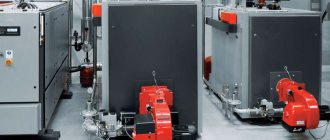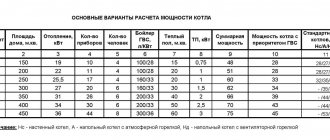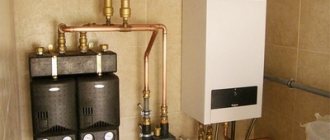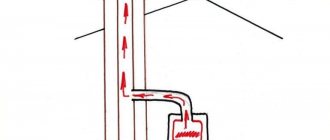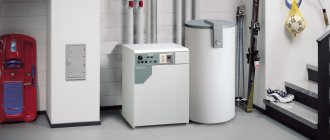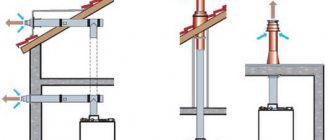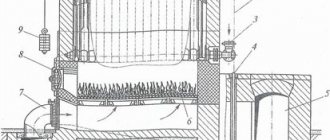The premises in which the gas boiler will operate are specified in SNiP 31-02-2001, DBN V.2.5-20-2001, SNiP II-35-76, SNiP 42-01-2002 and SP 41-104-2000 - these documents eliminate or minimize any emergency situations. Premises for placing gas boilers fall under the classification of fire and explosion hazards, therefore, when designing, planning, installing and setting up equipment for gas heating, all requirements for the premises for installing a gas boiler must be strictly observed.
General requirements for the installation of gas appliances
In the room intended for the installation of a gas boiler, according to the above standards, there must be good natural lighting: per 1 m3 there must be at least 0.03 m2 of window opening area (but not windows - partitions, frames and imposts are not taken into account). It is imperative to equip the room with a supply and exhaust ventilation system according to the following rules: the total volume of forward and reverse air flows per hour, multiplied by 3, is equal to the volume of the entire exhaust device. In addition to a window equipped with a window, a door with access to the street is installed in the room. The table shows the requirements for room volume:
| Gas boiler power | Total combustion volume |
| < 30 kW | 7.5 m3 |
| > 30-60 kW | 13.5 m3 |
| > 60-200 kW | Requirements according to the conditions of installation and operation of a gas boiler, but not less than 15 m3 |
Attention!
For gas-fired units with a power of more than 6000 W, 0.2 m3 should be added for each extra unit of power.
Supervisory requirements for the premises for installing a gas boiler stipulate that the operation of any appliances for heating an apartment is permitted on each floor of a multi-storey building and in any room of the apartment. Kitchens in multi-storey buildings also meet these requirements, since they are already equipped with appropriate communications. The only condition is that the total thermal power of all devices for heating water and heating the apartment (boilers, boilers, heating elements, heating radiators, batteries or registers) should not exceed a total of 150 kW.
The ceiling height in the room is 2 meters or more. The room in which the gas boiler will be installed and operated must be separated from adjacent rooms by solid fire-resistant walls. Material for walls or partitions must have a fire resistance time limit of 0.75 hours (45 minutes). The boiler room must be designed so that in the event of an operational fire there is no possibility for the fire to spread throughout the apartment.
Attention!
Gas boilers of the TLO brand, operating on the principle of natural coolant circulation, can be installed and should be operated only in the basement of the house or in the basement.
Installation of a gas wall-mounted boiler - kitchen requirements
- Ceiling - 2 meters and above.
- The total volume of the kitchen is more than 7.5 m3, ventilation is equipped, a window is installed and there is a door opening onto the balcony.
- For air exchange, it is necessary to install a grille at the bottom of the wall or door that opens into the next room; the area of the grille is at least 0.02 m2.
To install a gas boiler in the kitchen, you may need permission from the gas service.
If the kitchen in the apartment does not meet the requirements of SNiP, then gas heating equipment can be installed and operated only with the permission of the gas supervision authority.
Attention!
It is strictly forbidden to install more than 2 heating devices or more than 2 boilers in one room if the volume of the room is less than 7.5 m3
The existing rules for installing a gas boiler in a private house largely repeat the requirements for boilers that operate in apartments in multi-storey buildings. The differences are caused only by the fact that often in a private house a separate room or building is allocated for heating equipment, which is subject to additional requirements listed below.
Distance from the boiler room to a residential building and public buildings
The distance from the boiler room to a residential building is regulated by the SanPiN standard depending on the type of construction and the fuel used, as well as the purpose of the building. For gas, industrial purposes, free-standing, the cardinal requirements are 300 m.
- The distance to a residential building from the boiler room can be varied according to SNiP standards. When using solid fuel, separate calculations are made. The installation must be designed taking into account background noise. You should also take into account the incoming degrees of air pollution from combustion products. For extensions, there is a ban on building under apartment windows (at least 4 meters are left from the windows horizontally, and 8 meters vertically). It is prohibited to build an extension from the front of the building.
- From kindergartens and school institutions of various types, as well as medical facilities, the standards provide for developed projects. Only free-standing ones are allowed, provided that the walls of the boiler room achieve the required degrees of fire resistance, and the distance between the rooms is determined by the type of fuel and the necessary equipment from the boiler. In such establishments it is not permitted to build rooftop, built-in or attached boiler rooms due to the need for fuel storage, namely coal, peat or flammable liquids. Sanitary standards determine the required distance to the nearest window (due to combustion products and background noise), and the permissible distance from the fuel storage and boiler room is calculated according to the minimum fire distances.
- Federal legislation allows the construction of built-in, attached and roof-top boiler rooms in administrative buildings if the established standards for water temperature or pressure are met. It is also necessary to have access or open areas for maintenance. In the above types, liquid fuel is prohibited.
Rules for installing a floor-standing gas boiler
- In a house under construction, it is necessary to plan a separate room for installing a gas-fired boiler. The room should have a natural flow of air through a grille in the door or through a hole in the wall.
- A separate hole must be made for supply and exhaust ventilation - it must be located under the ceiling.
- A hole in the wall for the chimney pipe, a hole below the chimney for a soot brush (for cleaning the chimney pipe), which is made below the main chimney by 20-30 cm.
- The chimney is made airtight so that smoke and carbon dioxide do not flow back into the room. To ensure tightness, a smaller diameter pipe is installed inside the large chimney pipe, through which gas combustion products are discharged.
- The room intended for installation and operation of a gas boiler must be spacious and provide easy access and operation, maintenance and repair of the boiler. The floor in the furnace room must be made of non-combustible materials - concrete screed, natural stone, paving stones. The furnace room must be connected to the water supply for the operation of the water heating device, and be equipped with a sewerage system.
- The area of the room for the boiler is 4 m2, the height of the ceilings in the room is at least 2.5 m2.
- The outer door must be 80 cm wide.
- The top of the chimney should be higher than the roof. The cross-section of the chimney pipe must be larger than the diameter of the boiler outlet.
- To supply power, the boiler room must be equipped with an electrical panel with grounding.
- The gas line is brought into the room in advance. A separate valve must be installed for each gas appliance.
- The walls of the boiler room are plastered - it is strictly prohibited to decorate the walls with flammable materials (MDF, fiberboard, plastic).
Requirements for the premises of a boiler room in a private house
It is prohibited to store flammable liquids and objects near the furnace room and in the room itself. The foundation under the AOGV (gas heating unit or gas heating water heating unit) should not freeze in winter, therefore its depth should be below the level of soil freezing in a given region. The air from the vent should be clean, that is, the chimney should be located far from the vent. The room or building in which the gas boiler is installed cannot be equipped for other purposes.
Classification
Boiler room is a general collective term adopted by specialists for any type of functional structure.
The purpose of building such a complex is to produce thermal energy obtained in the form of steam or heated water.
The use of the resulting energy product implies differentiation into large-scale (industrial), combined (industrial-heating) and used for heating a home or public building. It is recommended to place such complexes of devices depending on the type, type of boiler and purpose of the installation, the option of connecting the produced thermal energy to the consumer and location.
To determine the required distance from the boiler room to public buildings, you should know the exact categorical affiliation of the heating complex according to all existing methods of delimitation. Based on the type of fuel used, there are several common types:
- gas, in which heat is generated by the combustion of hydrocarbon gases, which is widely recognized due to the efficiency and environmental friendliness of the fuel used;
- solid fuel, where there can be many options for raw materials - from coal and firewood to waste from industrial enterprises for processing wood or peat;
- liquid fuel, using flammable liquids, mainly petroleum products of various types;
- electric, of all categories the least economical, and therefore built quite rarely.
The distance standards from residential buildings and public buildings to the boiler room depend not only on the type of fuel used, but also on the type of placement of the building required for heating. By type of placement they are differentiated into:
- roof (permitted for installation on the roof of any building, subject to compliance with the required fire hazard class);
- capital buildings that provide significant power, built according to a special design with a foundation, floors and roof;
- attached and built into other buildings;
- frame on pallets and block-modular (which can be of different types - built-in, attached and even roof-mounted).
Fuel supply systems are also taken into account - mechanized, automated and manual, of which there are fewer and fewer. In the latter case, fuel is loaded into the firebox manually by a special worker. He not only loads solid fuel using a primitive device, but also cleans it of ash and slag manually.
The classification of boiler houses by location is given in SNiP 30-02-97 as amended in 2021 and SP 53.13330.2011. The placement of free-standing boiler rooms is carried out in accordance with the general plan and layout. Built-in ones cannot be placed in multi-apartment buildings, but attached ones have separate standards that depend on the type of structure.
The video below describes in detail the requirements for a gas boiler room in a private residential building in accordance with SNiP, SP and fire safety standards.
Rules for installing wall-mounted gas boilers in an apartment
Typically, in an apartment, a gas boiler is installed in the kitchen, since it already has a gas line, water supply and sewerage. That is, a priori, all requirements for the installation of gas equipment have already been met - all that remains is to connect the boiler. This state of affairs automatically reduces the cost of laying utilities and energy resources. It is prohibited to install a gas boiler in rooms with high humidity - in a bathroom, laundry room, etc.
There are several additional requirements for wall-mounted boilers:
- The wall or partition for hanging the boiler must be able to support it - equipment cannot be hung on a plasterboard or other light partition.
- If the wall is decorated with flammable materials (wallpaper, vinyl, plastic, MDF, fiberboard), then a 3 mm thick gasket of non-flammable material is installed between the gas wall-mounted boiler and the wall. In this case, the boiler must be secured with special hardware that ensures a distance from the boiler body to the wall of at least 4-5 cm.
- The minimum distance from the boiler to the ceiling and walls of the room is 0.5 meters. The distance from the boiler to the floor is 0.8 meters.
Before installing and starting up gas equipment, you must obtain all relevant documents. The main condition when installing a boiler in a private house that runs on gas is that an agreement on connecting the gas main is first concluded, and a project for the installation of gas equipment and gasification of the house is drawn up. These documents are developed and approved by the gas supplier in the region.
List of boiler room equipment
The construction of a boiler room is inextricably linked with the installation of heating equipment and boiler piping. Therefore, before starting work, it is important to draw up a list of devices planned for installation and select their locations.
The following heating equipment must be installed in the boiler room of every private house:
- Boiler is a device in which fuel is burned and heat is generated (the choice of model depends on the area of the house, the required power and the type of available fuel);
- Boiler , or water heater, necessary for heating water used for showering, washing dishes and other household needs;
- Manifold , which includes a circulation pump, a boiler room safety group, as well as a number of measuring and other instruments (pressure gauges, thermometers, etc.). The function of the collector system is to uniformly distribute the coolant (water) to all heating circuits: hot water taps, radiators, “warm floors”, etc.;
- The piping system is the main engineering communications through which the coolant flows from the boiler and collector to the radiators and water supply.
- An expansion tank designed to compensate for excess pressure in thermal systems. This element plays an important role in boiler equipment, because thanks to it, the pipeline and radiators are protected from increased pressure, which can result in a pipe burst;
- Thermal accumulator . It contains excess coolant produced by the boiler, which enters the radiators during periods of severe frost.
- Chimney - a vertical pipe for removing combustion products during the combustion of fuel inside the boiler (wall-mounted gas boilers require a coaxial type chimney that pulls smoke from the combustion chamber and releases it into the atmosphere, taking fresh air from it);
- Distribution comb - a part for distributing coolant through pipes and regulating its temperature;
The heating system includes additional equipment such as controllers, control systems, regulators, thermostatic valves, hydraulic arrows, etc.
The complexity of the boiler room layout and installation directly depends on the dimensions and configuration of the room, the number of connected equipment and consumers. The heated area does not always matter here: for example, a boiler room for a 100 m2 house can have 2 boilers, a storage water heater and, for example, a “warm floor” system. In any situation, specialist advice will be required.
